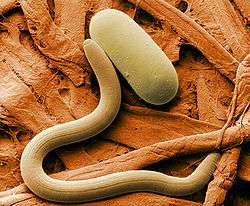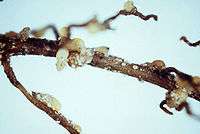Soybean cyst nematode
| Soybean cyst nematode | |
|---|---|
 | |
| Soybean cyst nematode and egg | |
| Scientific classification | |
| Kingdom: | Animalia |
| Phylum: | Nematoda |
| Class: | Chromadorea |
| Order: | Tylenchida |
| Family: | Heteroderidae |
| Subfamily: | Heteroderinae |
| Genus: | Heterodera |
| Species: | H. glycines |
| Binomial name | |
| Heterodera glycines Ichinohe, 1952 | |
The soybean cyst nematode (SCN), Heterodera glycines, is a plant-parasitic nematode and a devastating pest of the soybean (Glycine max) worldwide. The nematode infects the roots of soybean, and the female nematode eventually becomes a cyst. Infection causes various symptoms that may include chlorosis of the leaves and stems, root necrosis, loss in seed yield and suppression of root and shoot growth. SCN has threatened the U.S. crop since the 1950s, reducing returns to soybean producers by $500 million each year and reducing yields by as much as 75 percent.[1] It is also a significant problem in the soybean growing areas of South America and Asia.
Biology
The second-stage juvenile, or J2, nematode is the only life stage that can penetrate roots. (The first-stage juvenile occurs in the egg, and third- and fourth-stages occur in the roots). The J2 enters the root moving through the plant cells to the vascular tissue where it feeds. The J2 induces cell division in the root to form specialized feeding sites. As the nematode feeds, it swells. The female swells so much that her posterior end bursts out of the root and she becomes visible to the naked eye. In contrast, the adult male regains a wormlike shape, and he leaves the root in order to find and fertilize the large females. The female continues to feed as she lays 200 to 400 eggs in a yellow gelatinous matrix, forming an egg sac which remains inside her. She then dies and her cuticle hardens forming a cyst. The eggs may hatch when conditions in the soil are favorable, the larvae developing inside the cyst and the biological cycle repeating itself. There are usually three generations in the year. In the autumn or in unfavorable conditions, the cysts containing dormant larvae may remain intact in the soil for several years.[2] Although soybean is the primary host of SCN, other legumes can also serve as hosts.

Pathology
The aboveground symptoms of SCN infection are not unique to SCN infection, and could be confused with nutrient deficiency, particularly iron deficiency, stress from drought, herbicide injury or another disease. The first signs of infection are groups of plants with yellowing leaves that have stunted growth. The pathogen may also be difficult to detect on the roots, since stunted roots are also a common symptom of stress or plant disease. Observation of adult females and cysts on the roots is the only accurate way to detect and diagnose SCN infection in the field.
Distribution
The SCN is thought to be a native of Asia. It was first found in the United States in 1954 and spread with the expansion of soybean growing areas. SCN was also found in Colombia in the 1980s, and more recently in the major soybean producing areas in Argentina and Brazil. SCN has also been reported from Iran and Italy.
Locations
- Africa: Egypt
- Asia: Iran (Golestan Province and Mazandaran Province), China (Hebei, Hubei, Heilongjiang, Henan, Jiangsu, Liaoning), Indonesia (Java), Korean peninsula, Japan, Taiwan (unconfirmed), Russia (Amur District in the Far East).
- North America: Canada (Ontario), USA (Alabama, Arkansas, Delaware, Florida, Georgia, Illinois, Indiana, Iowa, Kansas, Kentucky, Louisiana, Maryland, Minnesota, Michigan, Mississippi, Missouri, Nebraska, New Jersey, North Carolina, North Dakota, Ohio, Oklahoma, Pennsylvania, South Carolina, South Dakota, Tennessee, Texas, Virginia and Wisconsin).
- South America: Argentina (unconfirmed), Brazil (unconfirmed), Chile, Columbia, Ecuador.
Control
Cultural practices, such as crop rotation and the use of resistant cultivars, are used to limit the damage due to SCN. Because SCN is an obligate parasite (requires a living host), a crop rotation involving non-host plants can decrease the population of SCN and has been shown to be an effective management tool. Plants that are already stressed are more susceptiable to infection, so good cultural practices, like maintaining soil fertility, pH and moisture can reduce the severity of infection. Chemical control with nematicides is not normally used because the economic and environmental costs are prohibitive.
Notes
- ↑ Cooperative State Research, Education, and Extension Service United States Department of Agriculture. 2000. Keeping the Profits in Soybeans
- ↑ AgroAtlas
References
| External identifiers for Heterodera glycines | |
|---|---|
| Encyclopedia of Life | 463223 |
| ITIS | 63573 |
| NCBI | 51029 |
- Davis, E.L. and G.L. Tylka. 2000. Soybean cyst nematode disease. The Plant Health Instructor. doi:10.1094/PHI-I-2000-0725-01
- Tylka, G. 1995. Soybean cyst nematode. Iowa State University, University Extension
External links
- Species Profile- Soybean Cyst Nematode (Heterodera glycines), National Invasive Species Information Center, United States National Agricultural Library. Lists general information and resources for Soybean Cyst Nematode.